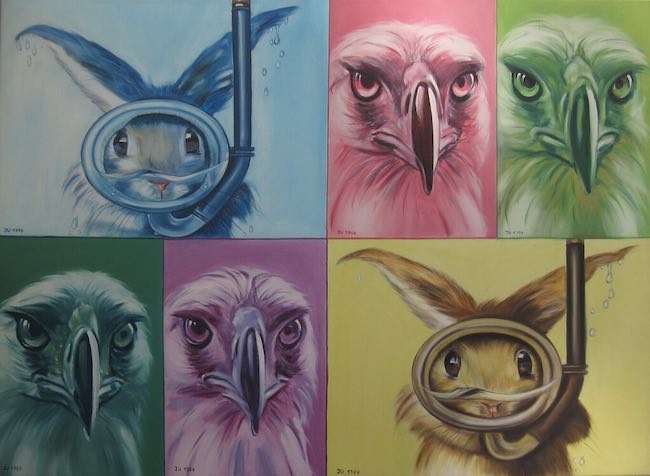Molto spesso osservare la realtà nella sua manifestazione più evidente può non essere sufficiente ad alcuni artisti che hanno bisogno di guardare oltre, di spingere il loro sguardo verso tutto quel sottile universo di connessioni e di energie impercettibili nella contingenza; quando si sviluppa questo tipo di approccio filosofico anche l’espressione pittorica o scultorea devono sintonizzarsi su quella frequenza dando vita a uno stile che se da un lato attinge al visibile, dall’altro lo supera e ne esplora gli enigmi, le profondità che aleggiano intorno all’essere umano senza che egli ne sia pienamente consapevole. La protagonista di oggi affida prevalentemente al mondo animale il compito di risvegliare, di sollecitare quella connessione con il lato più profondo della vita che accresce così la coscienza di sé e anche della forza delle proprie sensazioni.
Il Diciannovesimo secolo è stato un punto di svolta nel corso della storia dell’arte, perché se è vero che la pittura era ancora legata alla tradizione accademica sia dal punto di vista coloristico che da quello della figurazione, lo è altrettanto che molti dei principali movimenti pittorici che si alternarono negli ultimi decenni gettarono importanti basi per le correnti avanguardistiche che si affermarono agli inizi del secolo successivo, il Novecento. In particolar modo dopo la seconda metà dell’Ottocento iniziarono a delinearsi tecniche pittoriche sperimentali, come nel caso dell’Impressionismo con la sua scomposizione dell’immagine e l’attitudine a dipingere senza disegno preparatorio, oppure stili che pur attenendosi a un approccio più classico cominciavano a porre attenzione alle energie della natura, al sentire dell’individuo e al rapporto tra essere umano e spiritualità, tematiche che contraddistinsero invece il Simbolismo. Legato al movimento letterario secondo cui la verità poteva essere raggiunta attraverso la percezione e l’intuizione e dunque senza la mediazione della razionalità, il correlato movimento pittorico si fondava sulla manifestazione della spiritualità che appartiene alla realtà che circonda l’uomo e che raramente riesce a essere intravista; Gustave Moreau, con le sue rappresentazioni di idee irreali, e Odilon Redon, delicato nei dipinti e inquietante nei disegni, furono di fatto anticipatori delle tematiche affrontate qualche decennio dopo da un altro movimento, rivoluzionario nella forma e nelle tematiche, che prese il nome di Surrealismo e che dominò, insieme al Cubismo, la scena artistica dei primi decenni del Ventesimo secolo. L’attenzione alla mente umana, le sue paure, gli incubi, le ansie, che erano state ispirate dagli studi sulla psiche compiuti dal grande psicoanalista austriaco Sigmund Freud, furono i segni distintivi delle opere di Salvador Dalì, di René Magritte, diPaul Delvauxe di Max Ernst dove uno stile pittorico illusoriamente realista dava vita a scenari da incubo, a figure a metà umane e metà animali inquietanti e improbabili, o ambientazioni in cui l’essere umano sembrava essere assente o presente solo attraverso l’angoscia generata dalle immagini narrate. Il legame con il periodo storico in cui il movimento si sviluppò fu il motivo per il quale gli artisti sentivano la necessità di far emergere i fantasmi della mente, lo spaventoso mondo onirico dentro cui essa dava libero sfogo a tutto l’orrore che cercava di tenere a bada durante la fase di veglia. Nella contemporaneità l’attenzione all’individuo nella pittura si è sintonizzata su un più marcato esistenzialismo, l’individualità è divenuto rifugio per l’interiorità e l’uomo moderno ha saputo mettere al centro della sua riflessione tutte quelle insicurezze e fragilità che appartengono al vivere di oggi, dunque senza più la necessità di superare traumi e choc vissuti bensì prendendo atto del suo dover necessariamente trovare il modo per rafforzarsi, per rimanere in piedi davanti alle difficoltà affrontando tutte le sfaccettature esistenziali, spesso complesse.
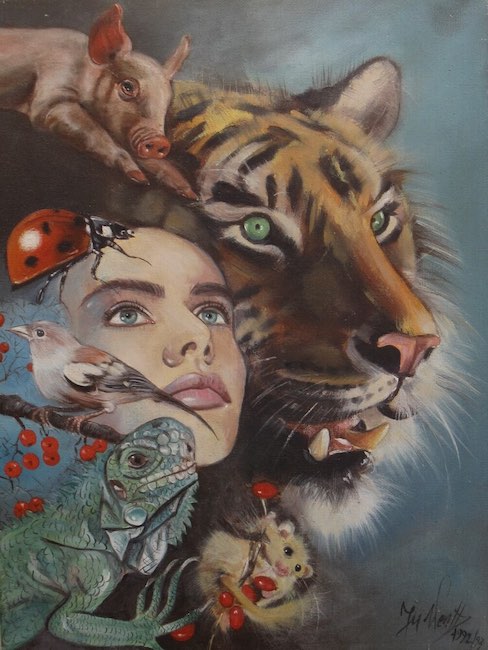
L’artista austriaca Jutta Wenth, che quest’anno festeggia i quarant’anni di apertura del suo atelier di Berg, nella Bassa Austria, costruito dai suoi genitori Christine ed Engelbert Wenth ormai scomparsi, affronta in maniera personale il tema della necessità per l’uomo di oggi di rimanere in contatto con il suo lato più spontaneo, selvaggio, che potrebbe soccombere davanti all’incalzante avanzamento della tecnologia potenzialmente spersonalizzante, quasi una minaccia alla sua naturalezza che invece è l’unica in grado di farlo restare umano.
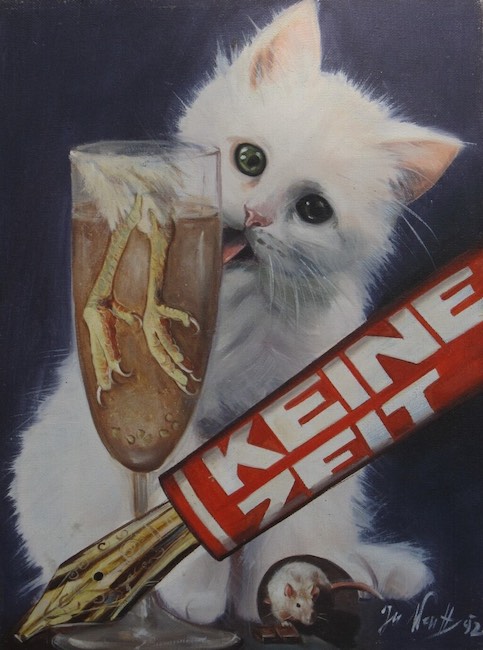
Lo stile pittorico surrealista, attenuato e privato da Jutta Wenth dagli eccessi del movimento originario e contraddistinto da un tratto pulito e da una perfetta definizione dell’immagine, si lega pertanto ai significati del Simbolismo che lei associa e lega imprescindibilmente al mondo animale come se quest’ultimo fosse guida per tutto ciò che l’uomo ha dimenticato, ha tralasciato in nome di una razionalità e di un inseguimento al progresso che di fatto sembra più un’involuzione che non un’evoluzione.
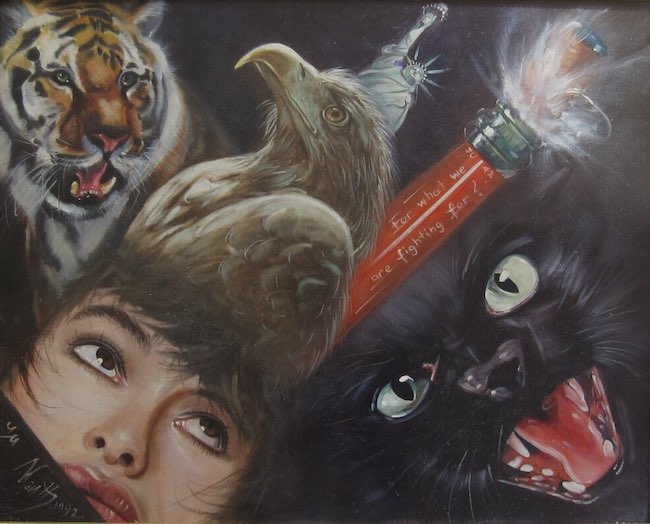
Nella tela What are we fighting for infatti, il volto della donna contraddistinto da un’espressione meditativa, è circondato da felini e da un’aquila, come se l’artista volesse contrapporre la lotta per la vita, quella che regola e domina la giungla, a quella fittizia della corsa all’ottenimento di obiettivi materiali, di cui è simbolo una Statua della Libertà ormai quasi privata del suo significato iniziale perché la nazione che la ospita si è trasformata in un mondo utilitarista. L’aggressività con cui ritrae i felini, allegoria dunque della competitività e dell’arrivismo che appartiene alla società attuale, viene mitigata dalla presenza dell’aquila posta sulla testa della donna, come a volerne essere scudo, mentre il collo di bottiglia appena stappata sembra essere una domanda sulla vacuità degli obiettivi apparentemente fondamentali eppure vuoti di contenuti, di consistenza di veri valori che dovrebbero al contrario essere la base della vita dell’uomo.
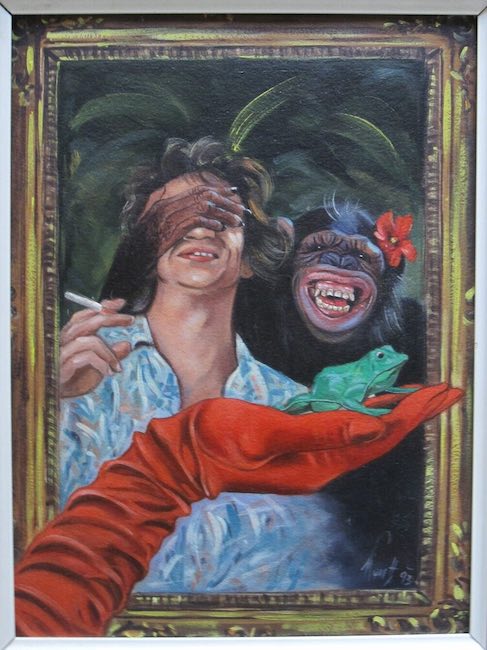
Nella tela Who is it?, Jutta Wenth sceglie di descrivere Jane Goodall, la grande antropologa britannica nota per gli studi sugli scimpanzé, nella sua veste più spontanea, rilassata e giocosa dove uno dei suoi amati animali scherza con lei e a cui lei risponde con un’irrefrenabile risata; ciò che fuoriesce da questa tela è il forte legame che la studiosa è riuscita a instaurare con le scimmie più simili, per abitudini e comportamenti, all’uomo di cui l’artista riproduce l’espressione divertita del gioco. Qui il Simbolismo si insinua nelle pieghe della realtà, ciò che viene messo in luce dall’artista è l’interpretazione di una scelta di vita, di un modo di essere e dell’ironia che alcuni animali riescono a tirare fuori anche dal carattere più serioso e analitico; il contatto con lo scimpanzé ha svelato il lato umano della scienziata, perché in fondo l’immersione nella natura rappresenta un ritorno a una spontaneità che nell’individuo adulto viene perduta. Nelle opere dedicate ai genitori, coloro i quali hanno fortemente creduto in Jutta Wenth e l’hanno incoraggiata a seguire il proprio percorso artistico al punto di regalarle l’atelier che quest’anno compie i quarant’anni di attività, lo sguardo pittorico vira verso il Realismo, perde la struttura surrealista e simbolista per trasformarsi in racconto, in narrazione di momenti di condivisione divenuti speciali nella memoria dell’artista, proprio perché non possono più tornare; e dunque la decisione di immortalare quei frammenti di esistenza diviene percorso emozionale nei confronti di un ricordo morbido e avvolgente tanto quanto lo è stato la presenza dei genitori nella vita della Wenth.
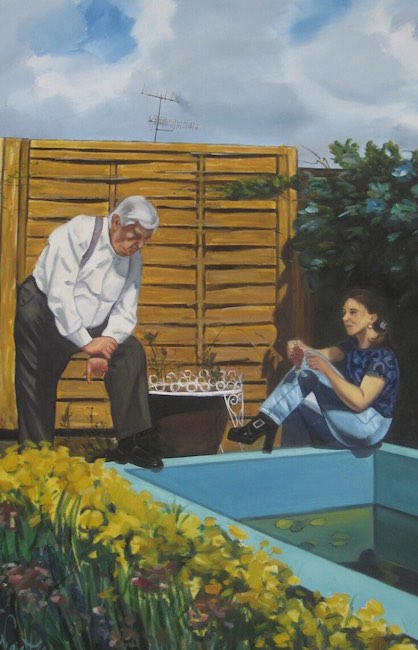
Questo tipo di sensazione è riscontrabile nella tela Vati + ich in unserem Biotop, che ritrae l’autrice in posa rilassata mentre chiacchiera amabilmente con suo padre, in un pomeriggio di primavera durante il quale la natura fa da splendida cornice a quel ricordo indelebile proprio perché immortalato nella sua immediatezza attraverso un’opera che ha generato un fermo immagine di quell’istante.
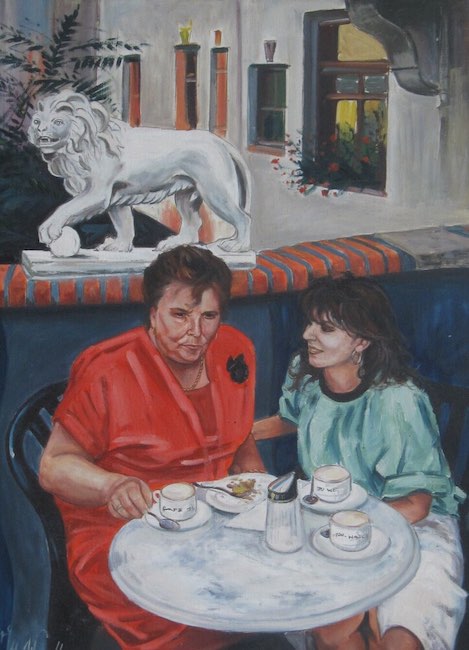
Altrettanto intensa e dolce è l’atmosfera che fuoriesce dalla tela Mama + ich im Hundertwasserhaus dove Jutta Wenth ritrae se stessa e sua madre mentre si rilassano facendo colazione durante un periodo di vacanza; la serenità dell’artista è evidente, tanto quanto la solennità della madre che sembra quasi voler nascondere la stima che prova per quella figlia artista in cui ha tanto creduto. Dunque la celebrazione di chi ha fortemente creduto in lei porta Jutta Wenth a voler celebrare in modo particolare questo quarantesimo anno di attività del suo atelier che ha visto sbocciare ed evolvere il suo stile pittorico dando vita a un linguaggio unico e inconfondibile, esattamente come avevano sognato i suoi genitori.
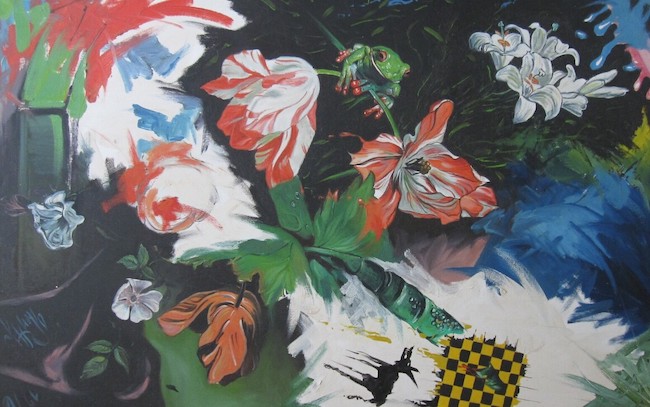
Jutta Wenth ha al suo attivo mostre collettive e personali in Austria, Germania, Spagna, Italia e UK, in spazi pubblici e presso gallerie private, le sue opere fanno parte di importanti pubblicazioni e cataloghi; il 4 luglio 2024 sarà inaugurata la mostra The 40 Years of Atelier, dedicata alla sua carriera artistica e alla memoria dei suoi genitori.
JUTTA WENTH-CONTATTI
Email: jutta.wenth.art@gmail.com
Sito web: www.juttawenth.at
The Symbolist Surrealism by Jutta Wenth, where animal instinct becomes a guide and food for thought for human emotion
Very often observing reality in its most obvious manifestation may not be enough for some artists who need to look beyond it, to push their gaze towards that subtle universe of connections and energies imperceptible in contingency; when this type of philosophical approach is developed, even pictorial or sculptural expression must tune in to that frequency, giving life to a style that, while on the one hand draws on the visible, on the other goes beyond it and explores the enigmas, the depths that hover around the human being without him being fully aware of them. Today’s protagonist predominantly entrusts the animal world with the task of awakening, of soliciting that connection with the deeper side of life that thus increases self-awareness and also the power of one’s own sensations.
The 19th century was a turning point in the course of art history, because while it is true that painting was still tied to the academic tradition in terms of both colourism and figuration, it is equally true that many of the major painting movements that took turns in the last decades laid important foundations for the avant-garde currents that established themselves at the beginning of the next century, the 20th. Particularly after the second half of the 19th century, began to emerge experimental painting techniques, as in the case of Impressionism with its decomposition of the image and the attitude of painting without a preparatory drawing, or styles that, while adhering to a more classical approach, began to pay attention to the energies of nature, the feeling of the individual and the relationship between the human being and spirituality, themes that characterised Symbolism. Linked to the literary movement according to which truth could be reached through perception and intuition and thus without the mediation of rationality, the related pictorial movement was based on the manifestation of the spirituality that belongs to the reality that surrounds man and that rarely manages to be glimpsed; Gustave Moreau, with his representations of unreal ideas, and Odilon Redon, delicate in his paintings and disturbing in his drawings, were in fact forerunners of the themes addressed a few decades later by another movement, revolutionary in form and theme, which took the name Surrealism and which dominated, along with Cubism, the art scene of the first decades of the 20th century. The focus on the human mind, its fears, nightmares, anxieties, which had been inspired by the studies on the psyche carried out by the great Austrian psychoanalyst Sigmund Freud, were the hallmarks of the works of Salvador Dali, René Magritte, Paul Delvaux and Max Ernst where an illusory realist painting style gave life to nightmarish scenarios, to disturbing and improbable half-human and half-animal figures, or settings in which the human being seemed to be absent or present only through the anguish generated by the narrated images.
The link with the historical period in which the movement developed was the reason why artists felt the need to bring out the ghosts of the mind, the frightening dream world within which it gave free rein to all the horror it tried to keep at bay during the waking phase. In contemporary times, the focus on the individual in painting has tuned into a more marked existentialism, individuality has become a refuge for inwardness and modern man has been able to focus on all those insecurities and frailties that belong to today living, thus no longer needing to overcome traumas and shocks he has experienced, but rather taking note of his need to find a way to strengthen himself, to remain on his feet in the face of difficulties by dealing with all the often complex existential facets. The Austrian artist Jutta Wenth, who this year celebrates the 40th anniversary of the opening of her studio in Berg, Lower Austria, built by her parents Christine and Engelbert Wenth, who have now passed away, tackles in a personal way the theme of the need for today’s man to remain in touch with his more spontaneous, wild side, which could succumb in the face of the pressing advancement of potentially depersonalising technology, almost a threat to his naturalness, which is instead the only one capable of keeping him human. Jutta Wenth‘s surrealist pictorial style, softened and deprived of the excesses of the original movement and characterised by a clean stroke and perfect definition of the image, is therefore linked to the meanings of Symbolism, which she inextricably associates and binds to the animal world as if the latter were a guide to all that man has forgotten, has left behind in the name of a rationality and pursuit of progress that in fact seems more like involution than evolution. In the canvas What are we fighting for, in fact, the woman’s face, characterised by a meditative expression, is surrounded by felines and an eagle, as if the artist wanted to contrast the struggle for life, the one that regulates and dominates the jungle, with the fictitious one of the race to obtain material objectives, symbolised by a Statue of Liberty now almost deprived of its initial meaning because the nation that hosts it has turned into a utilitarian world.
The aggressiveness with which she portrays the felines, an allegory therefore of the competitiveness and arrivism that belongs to today’s society, is mitigated by the presence of the eagle placed on the woman’s head, as if to be her shield, while the neck of a bottle that has just been uncorked seems to be a question on the emptiness of objectives that are apparently fundamental yet empty of content, of the consistency of true values that should on the contrary be the basis of man’s life. In the canvas Who is it?, Jutta Wenth chooses to depict Jane Goodall, the great British anthropologist known for her studies on chimpanzees, in her most spontaneous, relaxed and playful guise, where one of her beloved animals jokes with her and to which she responds with an irrepressible laugh; what emerges from this canvas is the strong bond that the researcher has managed to establish with the apes most similar in habits and behaviour to man, of which the artist reproduces the amused expression of playfulness. Here Symbolism insinuates itself into the folds of reality, what the artist brings to light is the interpretation of a choice of life, of a way of being and of the irony that some animals manage to pull out of even the most serious and analytical character; contact with the chimpanzee has revealed the human side of the scientist, because after all, immersion in nature represents a return to a spontaneity that is lost in the adult individual. In the works dedicated to her parents, those who strongly believed in Jutta Wenth and encouraged her to follow her artistic path to the point of giving her the atelier, which celebrates its 40th anniversary this year, the pictorial gaze turns towards Realism, loses its Surrealist and Symbolist structure to turn into a tale, into a narration of shared moments that have become special in the artist’s memory, precisely because they can never return; and thus the decision to immortalise those fragments of existence becomes an emotional journey towards a memory as soft and embracing as the presence of her parents was in Wenth‘s life.
This type of sensation can be seen in the canvas Vati + ich in unserem Biotop, which portrays the author in a relaxed pose while chatting amiably with her father, on a spring afternoon during which nature provides a splendid frame for that indelible memory precisely because it is immortalised in its immediacy through a painting that has generated a still image of that instant. Equally intense and sweet is the atmosphere that emerges from the canvas Mama + ich im Hundertwasserhaus where Jutta Wenth portrays herself and her mother while they are relaxing over breakfast during a holiday period; the artist’s serenity is evident, as much as the solemnity of the mother who seems almost to want to hide the esteem she feels for her artist daughter in whom she has believed so much. Thus, the celebration of those who strongly believed in her brings Jutta Wenth to want to celebrate in a special way this 40th year of her atelier, which has seen her painting style blossom and evolve into a unique and unmistakable language, exactly as her parents had dreamed. Jutta Wenth has group and solo exhibitions to her credit in Austria, Germany, Spain, Italy and the UK, in public spaces and private galleries, her works are part of important publications and catalogues; on 4 July 2024 will be opened the exhibition The 40 Years of Atelier, dedicated to her artistic career and to the memory of her parents.


